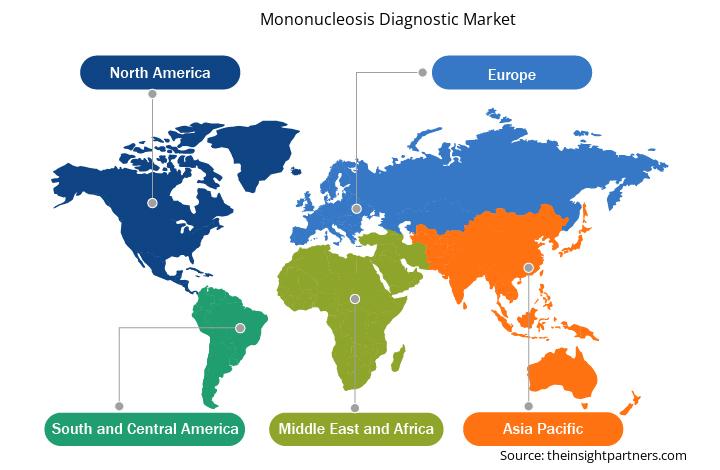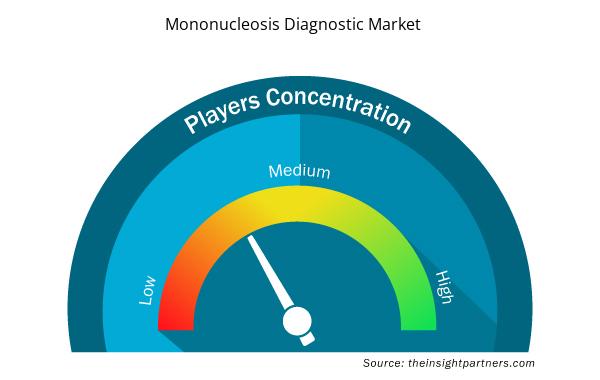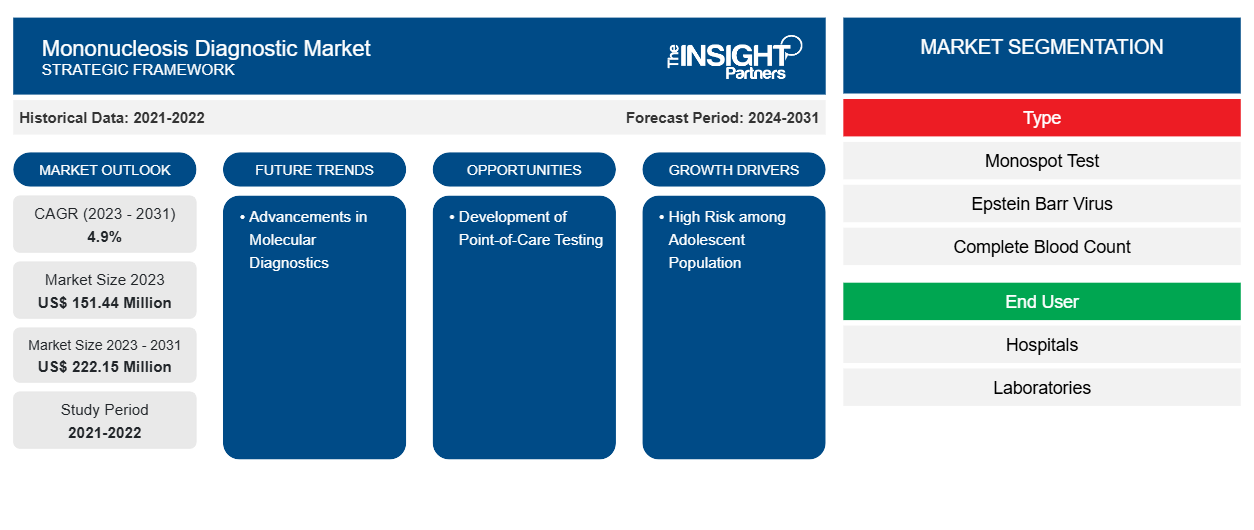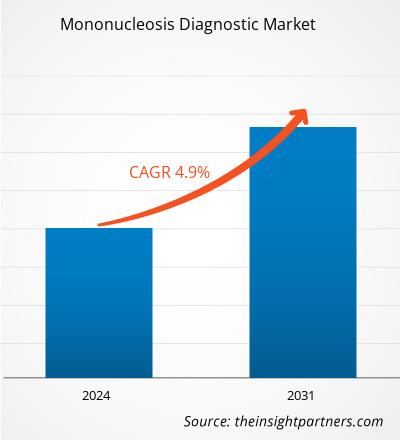Der Markt für Mononukleosediagnostik soll von 151,44 Millionen US-Dollar im Jahr 2023 auf 222,15 Millionen US-Dollar im Jahr 2031 anwachsen. Der Markt soll zwischen 2023 und 2031 eine durchschnittliche jährliche Wachstumsrate (CAGR) von 4,9 % verzeichnen. Fortschritte in der Molekulardiagnostik werden im Prognosezeitraum wahrscheinlich neue Markttrends mit sich bringen.
Mononukleose-Diagnostik Marktanalyse
Nach der Definition der Vereinten Nationen durchläuft die jugendliche Bevölkerung (10–19 Jahre) eine Übergangsphase von der Kindheit zum Erwachsenenalter mit erheblichem Wachstum und Entwicklung. Laut dem Kinderhilfswerk der Vereinten Nationen (UNICEF) gibt es weltweit 1,3 Milliarden Jugendliche, was 16 % der gesamten Weltbevölkerung entspricht. Mononukleose, oft auch als „Kusskrankheit“ bezeichnet, betrifft hauptsächlich Jugendliche und junge Erwachsene. Die Häufigkeit dieser Krankheit steigt mit der wachsenden jugendlichen Bevölkerung. Das Epstein-Barr-Virus (EBV) ist die häufigste Ursache dieser Krankheit, die sich oft durch Speichel beim Küssen oder gemeinsamen Trinken von Getränken verbreitet.
Gesundheitsdienstleister verzeichnen eine hohe Nachfrage nach effektiven Diagnosetests zur Erkennung und Bestätigung von Mononukleose bei Jugendlichen. Monospot-Tests, EBV-Antikörpertests und Rachenkulturen sind die etablierten Diagnosemethoden für diese Krankheit. Beim Monospot-Test werden bestimmte Antikörper im Blut nachgewiesen, während sich der EBV-Antikörpertest speziell auf die Erkennung von Anti-EBV-Antikörpern konzentriert. Viele Gesundheitsdienstleister konzentrieren sich auch darauf, Point-of-Care-Tests und Telegesundheitsdienste anzubieten, die sich speziell an jüngere Patienten richten, die die Bequemlichkeit einer schnellen Diagnose zu Hause bevorzugen. Diese Innovationen erleichtern die zeitnahe Diagnose, verringern Zugangsbarrieren und erhöhen die Gesamttestrate. Die Möglichkeit, Fälle von Mononukleose schnell zu identifizieren, führt zu einer besseren Patientenbehandlung und minimiert die Auswirkungen der Krankheit auf das akademische und soziale Leben. Das hohe Risiko einer Mononukleose bei Jugendlichen führt daher zu einer erheblichen Nachfrage nach Diagnoseprodukten und -dienstleistungen.
Marktübersicht zur Mononukleosediagnostik
Der Markt für Mononukleosediagnostik wächst aufgrund des hohen Risikos bei Jugendlichen und des steigenden Gesundheitsbewusstseins und Wissens über die Krankheit rasant. Führende Akteure auf dem Markt konzentrieren sich auf Innovation und Zusammenarbeit, um die Produktverfügbarkeit zu verbessern. Darüber hinaus dürften Fortschritte in der Molekulardiagnostik in den kommenden Jahren neue Markttrends mit sich bringen. Die geringe Genauigkeit bestehender Diagnosetests behindert jedoch das Wachstum des Marktes für Mononukleosediagnostik.
Passen Sie diesen Bericht Ihren Anforderungen an
Sie erhalten kostenlos individuelle Anpassungen an jedem Bericht, einschließlich Teilen dieses Berichts oder einer Analyse auf Länderebene, eines Excel-Datenpakets sowie tolle Angebote und Rabatte für Start-ups und Universitäten.
- Holen Sie sich die wichtigsten Markttrends aus diesem Bericht.Dieses KOSTENLOSE Beispiel umfasst eine Datenanalyse von Markttrends bis hin zu Schätzungen und Prognosen.
Treiber und Chancen auf dem Markt für Mononukleosediagnostik
Steigendes Gesundheitsbewusstsein und Wissen über Mononukleose treiben Marktwachstum voran
Das steigende Gesundheitsbewusstsein und Wissen über Mononukleose sind die Schlüsselfaktoren, die den Markt für Mononukleosediagnostik antreiben. Da die Menschen besser über Gesundheitsprobleme informiert sind, insbesondere über einzigartige Infektionskrankheiten wie Mononukleose, neigen sie dazu, proaktiver nach Diagnose und Behandlung zu suchen. Mit verbesserter Gesundheitskompetenz sind Menschen besser in der Lage, die Symptome von Mononukleose zu erkennen, darunter extreme Müdigkeit , Fieber, Halsschmerzen und geschwollene Lymphknoten. Eine frühzeitige Erkennung ist auch für eine wirksame Behandlung von entscheidender Bedeutung, da sie Komplikationen vorbeugt und die Dauer der Krankheit verkürzt. Der Zugang zu Informationen über das Internet, soziale Medien und Aufklärungskampagnen ermöglicht es den Patienten, diese Symptome mit größerer Sicherheit zu erkennen. Infolgedessen führt das gestiegene Bewusstsein zu einem Anstieg der Nachfrage nach Diagnosetests.
Der Aufstieg der sozialen Medien und Online-Gesundheitsressourcen hat die Art und Weise, wie Menschen auf Informationen zu Gesundheitsproblemen zugreifen, grundlegend verändert. Plattformen wie Instagram, Twitter und Facebook dienen als Kanäle zum Austausch persönlicher Erfahrungen und Expertenwissen im Zusammenhang mit Mononukleose. Influencer, Gesundheitsexperten und Organisationen nutzen diese Plattformen, um genaue Informationen zu verbreiten, die Krankheit zu entmystifizieren und Fehlinformationen zu bekämpfen. Infolgedessen werden die Menschen immer besser über Mononukleose informiert, was zu einer stärkeren Einbindung der Patienten in die Entscheidungsfindung hinsichtlich des Managements, der Diagnose und der Behandlung der Krankheit führt. Der Wandel der Denkweise kommt den Patienten zugute und verbessert das gesamte Gesundheitssystem, indem er ein proaktives Gesundheitsmanagement fördert.
Das steigende Gesundheitsbewusstsein steht auch im Einklang mit dem allgemeinen Trend zur Vorsorge, den Gesundheitssysteme weltweit verfolgen. Die Betonung der Prävention treibt die Nachfrage nach diagnostischen Tests für Mononukleose an. Gesundheitsdienstleister reagieren darauf, indem sie Routineuntersuchungen und Schulungsmaterialien in ihre Praktiken integrieren und so den Prozess der Diagnosefindung weiter normalisieren.
Entwicklung von Point-of-Care-Tests zur Schaffung lukrativer Marktchancen
POC-Tests ermöglichen eine schnelle Diagnose am oder in der Nähe des Patientenversorgungsorts, sodass Gesundheitsdienstleister sofortige klinische Entscheidungen treffen und die Behandlungsergebnisse verbessern können. Bei herkömmlichen Labortests dauert es oft Stunden oder Tage, bis Ergebnisse vorliegen, was die Behandlung verzögern und die Symptome verschlimmern kann. Im Gegensatz dazu können POC-Tests innerhalb von Minuten Ergebnisse liefern und so ein rechtzeitiges Eingreifen ermöglichen. Die schnelle Bearbeitung ist insbesondere bei Erkrankungen wie Mononukleose von entscheidender Bedeutung, da eine frühzeitige Diagnose Komplikationen reduzieren und den Patientenkomfort verbessern kann. POC-Tests können in verschiedenen Gesundheitseinrichtungen durchgeführt werden, darunter Ambulanzen, Notaufnahmen und Einrichtungen der häuslichen Pflege. Die Zugänglichkeit ist insbesondere in Gebieten mit begrenzter Laborinfrastruktur oder in ländlichen Regionen mit unzureichenden Gesundheitsressourcen von Vorteil. Indem die Diagnosemöglichkeiten in Form von POC-Tests näher an die Patienten gebracht werden, wird sichergestellt, dass mehr Personen rechtzeitig diagnostiziert und angemessen versorgt werden, wodurch die Reichweite der Gesundheitsdienste erweitert wird. Darüber hinaus fördert diese Art von Tests ein stärkeres Engagement, da die Patienten ihre Ergebnisse schnell erhalten und die nächsten Schritte mit ihren Gesundheitsdienstleistern besprechen können.
POC-Tests können im Vergleich zu herkömmlichen Labortests kostengünstiger sein, da sie keine umfangreiche Laborinfrastruktur erfordern, was wiederum die Gesamtkosten für Gesundheitssysteme senkt. Die Erschwinglichkeit von Mononukleose-Tests macht sie außerdem einem breiteren Patientenkreis zugänglich, insbesondere unterversorgten Bevölkerungsgruppen. Jüngste Fortschritte bei Biosensoren und Mikrofluidtechnologien treiben die Entwicklung ausgefeilterer POC-Tests mit verbesserter Sensitivität und Spezifität voran. Diese Innovationen gewährleisten die Zuverlässigkeit von POC-Tests beim Nachweis von Mononukleose. Zu den Marktteilnehmern, die POC-Testkits anbieten, gehören SEKISUI Diagnostics (OSOM Mono Test), Abbott (Clearview Mono) und Cardinal Health [Cardinal Health MONO (Mononucleosis) II Rapid Test]. Somit bietet die Entwicklung von POC-Tests erhebliche Wachstumschancen für die Akteure auf dem Markt für Mononukleosediagnostik.
Segmentierungsanalyse des Marktberichts zur Mononukleosediagnostik
Schlüsselsegmente, die zur Ableitung der Marktanalyse zur Mononukleosediagnostik beigetragen haben, sind Typ und Endbenutzer.
- Basierend auf dem Typ ist der Markt für Mononukleosediagnostik in Epstein-Barr-Virus-Antikörpertests, Blutbildtests und Monospot-Tests unterteilt. Das Segment der Monospot-Tests hatte im Jahr 2023 den größten Marktanteil.
- In Bezug auf den Endverbraucher wird der Markt für Mononukleosediagnostik in Krankenhäuser, Labore und andere unterteilt. Das Krankenhaussegment dominierte den Markt im Jahr 2023.
Mononukleose-Diagnostik Marktanteilsanalyse nach Geografie
Der geografische Umfang des Marktberichts zur Mononukleosediagnostik konzentriert sich hauptsächlich auf fünf Regionen: Nordamerika, Asien-Pazifik, Europa, Süd- und Mittelamerika sowie den Nahen Osten und Afrika. In Bezug auf den Umsatz dominierte Nordamerika den Markt im Jahr 2023. Es wird geschätzt, dass es im Prognosezeitraum den globalen Markt dominieren wird. Die USA sind der größte Markt für Mononukleosediagnostik weltweit und werden den Markt voraussichtlich auch im Prognosezeitraum dominieren. Das Marktwachstum in den USA ist auf technologische Fortschritte, ein gestiegenes Bewusstsein und einen ständigen Bedarf an wirksamen Strategien zur Krankheitsbehandlung zurückzuführen. Laut den National Institutes of Health verzeichnen die USA jedes Jahr etwa 125.000 Fälle von infektiöser Mononukleose. Aufgrund dieser hohen Zahl steigt auch das Bewusstsein für die durch das Epstein-Barr-Virus (EBV) verursachte Mononukleose im Land, was die Nachfrage nach schnellen und genauen Diagnosetestkits, Verbrauchsmaterialien und Dienstleistungen stärkt. Zu den verschiedenen Testmethoden, die von Gesundheitsdienstleistern im Land angewendet werden, gehören serologische Tests auf der Grundlage von Antikörpernachweisen und molekulare Tests mit Schwerpunkt auf der Identifizierung viraler DNA. Das Wettbewerbsumfeld auf dem Mononukleose-Diagnostikmarkt in den USA wird von Unternehmen wie Abbott Laboratories, Roche Diagnostics und Siemens Healthineers dominiert. Diese Unternehmen investieren in Innovationen und Kooperationen, um ihr Produktangebot zu verbessern und ihre Marktpräsenz auszubauen.
Regionale Einblicke in den Markt für Mononukleosediagnostik
Die regionalen Trends und Faktoren, die den Markt für Mononukleosediagnostik im Prognosezeitraum beeinflussen, wurden von den Analysten von Insight Partners ausführlich erläutert. In diesem Abschnitt werden auch die Marktsegmente und die Geografie der Mononukleosediagnostik in Nordamerika, Europa, im asiatisch-pazifischen Raum, im Nahen Osten und Afrika sowie in Süd- und Mittelamerika erörtert.

- Erhalten Sie regionale Daten zum Markt für Mononukleosediagnostik
Umfang des Marktberichts zur Mononukleosediagnostik
| Berichtsattribut | Details |
|---|---|
| Marktgröße im Jahr 2023 | 151,44 Millionen US-Dollar |
| Marktgröße bis 2031 | 222,15 Millionen US-Dollar |
| Globale CAGR (2023 - 2031) | 4,9 % |
| Historische Daten | 2021-2022 |
| Prognosezeitraum | 2024–2031 |
| Abgedeckte Segmente | Nach Typ
|
| Abgedeckte Regionen und Länder | Nordamerika
|
| Marktführer und wichtige Unternehmensprofile |
|
Marktteilnehmerdichte für Mononukleosediagnostik: Auswirkungen auf die Geschäftsdynamik verstehen
Der Markt für Mononukleosediagnostik wächst rasant, angetrieben durch die steigende Nachfrage der Endnutzer aufgrund von Faktoren wie sich entwickelnden Verbraucherpräferenzen, technologischen Fortschritten und einem größeren Bewusstsein für die Vorteile des Produkts. Mit steigender Nachfrage erweitern Unternehmen ihr Angebot, entwickeln Innovationen, um die Bedürfnisse der Verbraucher zu erfüllen, und nutzen neue Trends, was das Marktwachstum weiter ankurbelt.
Die Marktteilnehmerdichte bezieht sich auf die Verteilung der Firmen oder Unternehmen, die in einem bestimmten Markt oder einer bestimmten Branche tätig sind. Sie gibt an, wie viele Wettbewerber (Marktteilnehmer) in einem bestimmten Marktraum im Verhältnis zu seiner Größe oder seinem gesamten Marktwert präsent sind.
Die wichtigsten auf dem Markt für Mononukleosediagnostik tätigen Unternehmen sind:
- Abbott Laboratories
- Arlington Scientific Inc
- Bio-Rad Laboratories Inc
- Cardinal Health Inc
- Meridian Bioscience Inc
- Sekisui Diagnostics LLC
Haftungsausschluss : Die oben aufgeführten Unternehmen sind nicht in einer bestimmten Reihenfolge aufgeführt.

- Überblick über die wichtigsten Akteure auf dem Markt für Mononukleosediagnostik
Neuigkeiten und aktuelle Entwicklungen zum Mononukleose-Diagnostikmarkt
Der Markt für Mononukleosediagnostik wird durch die Erhebung qualitativer und quantitativer Daten nach Primär- und Sekundärforschung bewertet, die wichtige Unternehmensveröffentlichungen, Verbandsdaten und Datenbanken umfasst. Im Folgenden finden Sie eine wichtige Entwicklung auf dem Markt für Mononukleosediagnostik:
- Meridian Bioscience, Inc., ein weltweit führender Anbieter von diagnostischen Testlösungen und Rohstoffen für die Biowissenschaften, hat zusammen mit SD Biosensor, Inc. und SJL Partners LLC den Abschluss ihrer Übernahme von Meridian bekannt gegeben. (Quelle: Website von Meridian Bioscience, Inc., Januar 2024)
Marktbericht zur Mononukleosediagnostik – Umfang und Ergebnisse
Der Bericht „Marktgröße und Prognose für Mononukleosediagnostik (2021–2031)“ bietet eine detaillierte Analyse des Marktes, die die folgenden Bereiche abdeckt:
- Mononukleose-Diagnostikmarktgröße und -prognose auf globaler, regionaler und Länderebene für alle wichtigen Marktsegmente, die im Rahmen des Berichts abgedeckt sind
- Markttrends für Mononukleose-Diagnostika sowie Marktdynamiken wie Treiber, Einschränkungen und wichtige Chancen
- Detaillierte PEST- und SWOT-Analyse
- Marktanalyse für Mononukleosediagnostik mit Blick auf wichtige Markttrends, globale und regionale Rahmenbedingungen, wichtige Akteure, Vorschriften und aktuelle Marktentwicklungen
- Branchenlandschaft und Wettbewerbsanalyse, einschließlich Marktkonzentration, Heatmap-Analyse, prominenten Akteuren und aktuellen Entwicklungen auf dem Markt für Mononukleosediagnostik
- Detaillierte Firmenprofile
- Historische Analyse (2 Jahre), Basisjahr, Prognose (7 Jahre) mit CAGR
- PEST- und SWOT-Analyse
- Marktgröße Wert/Volumen – Global, Regional, Land
- Branche und Wettbewerbsumfeld
- Excel-Datensatz



Report Coverage
Revenue forecast, Company Analysis, Industry landscape, Growth factors, and Trends

Segment Covered
This text is related
to segments covered.

Regional Scope
North America, Europe, Asia Pacific, Middle East & Africa, South & Central America

Country Scope
This text is related
to country scope.
Häufig gestellte Fragen
The market is expected to register a CAGR of 4.9% during 2023–2031.
The mononucleosis diagnostic market value is expected to reach US$ 222.15 million by 2031.
Advancements in molecular diagnostics are likely to bring new growth trends in the market in the coming years.
Abbott Laboratories, Arlington Scientific Inc, Bio-Rad Laboratories Inc, Cardinal Health Inc, Meridian Bioscience Inc, Sekisui Diagnostics LLC, Thermo Fisher Scientific Inc, QuidelOrtho Corp, F. Hoffmann-La Roche Ltd, QIAGEN NV, Hologic Inc, bioMerieux SA, DiaSorin SpA, Immunostics Inc., Launch Diagnostics Ltd, Biorex Diagnostics, and ZEUS Scientific are among the key players operating in the market.
The high risk among the adolescent population, and the rising health awareness and knowledge about mononucleosis are among the most significant factors fueling the market growth.
North America dominated the market in 2023.
Trends and growth analysis reports related to Life Sciences : READ MORE..
The List of Companies - Mononucleosis Diagnostic Market
- Abbott Laboratories
- Arlington Scientific Inc
- Bio-Rad Laboratories Inc
- Cardinal Health Inc
- Meridian Bioscience Inc
- Sekisui Diagnostics LLC
- Thermo Fisher Scientific Inc
- QuidelOrtho Corp
- F. Hoffmann-La Roche Ltd
- QIAGEN NV
- Hologic Inc
- bioMerieux SA
- DiaSorin SpA
- Immunostics Inc.
- Launch Diagnostics Ltd
- Biorex Diagnostics
- ZEUS Scientific
The Insight Partners performs research in 4 major stages: Data Collection & Secondary Research, Primary Research, Data Analysis and Data Triangulation & Final Review.
- Data Collection and Secondary Research:
As a market research and consulting firm operating from a decade, we have published and advised several client across the globe. First step for any study will start with an assessment of currently available data and insights from existing reports. Further, historical and current market information is collected from Investor Presentations, Annual Reports, SEC Filings, etc., and other information related to company’s performance and market positioning are gathered from Paid Databases (Factiva, Hoovers, and Reuters) and various other publications available in public domain.
Several associations trade associates, technical forums, institutes, societies and organization are accessed to gain technical as well as market related insights through their publications such as research papers, blogs and press releases related to the studies are referred to get cues about the market. Further, white papers, journals, magazines, and other news articles published in last 3 years are scrutinized and analyzed to understand the current market trends.
- Primary Research:
The primarily interview analysis comprise of data obtained from industry participants interview and answers to survey questions gathered by in-house primary team.
For primary research, interviews are conducted with industry experts/CEOs/Marketing Managers/VPs/Subject Matter Experts from both demand and supply side to get a 360-degree view of the market. The primary team conducts several interviews based on the complexity of the markets to understand the various market trends and dynamics which makes research more credible and precise.
A typical research interview fulfils the following functions:
- Provides first-hand information on the market size, market trends, growth trends, competitive landscape, and outlook
- Validates and strengthens in-house secondary research findings
- Develops the analysis team’s expertise and market understanding
Primary research involves email interactions and telephone interviews for each market, category, segment, and sub-segment across geographies. The participants who typically take part in such a process include, but are not limited to:
- Industry participants: VPs, business development managers, market intelligence managers and national sales managers
- Outside experts: Valuation experts, research analysts and key opinion leaders specializing in the electronics and semiconductor industry.
Below is the breakup of our primary respondents by company, designation, and region:

Once we receive the confirmation from primary research sources or primary respondents, we finalize the base year market estimation and forecast the data as per the macroeconomic and microeconomic factors assessed during data collection.
- Data Analysis:
Once data is validated through both secondary as well as primary respondents, we finalize the market estimations by hypothesis formulation and factor analysis at regional and country level.
- Macro-Economic Factor Analysis:
We analyse macroeconomic indicators such the gross domestic product (GDP), increase in the demand for goods and services across industries, technological advancement, regional economic growth, governmental policies, the influence of COVID-19, PEST analysis, and other aspects. This analysis aids in setting benchmarks for various nations/regions and approximating market splits. Additionally, the general trend of the aforementioned components aid in determining the market's development possibilities.
- Country Level Data:
Various factors that are especially aligned to the country are taken into account to determine the market size for a certain area and country, including the presence of vendors, such as headquarters and offices, the country's GDP, demand patterns, and industry growth. To comprehend the market dynamics for the nation, a number of growth variables, inhibitors, application areas, and current market trends are researched. The aforementioned elements aid in determining the country's overall market's growth potential.
- Company Profile:
The “Table of Contents” is formulated by listing and analyzing more than 25 - 30 companies operating in the market ecosystem across geographies. However, we profile only 10 companies as a standard practice in our syndicate reports. These 10 companies comprise leading, emerging, and regional players. Nonetheless, our analysis is not restricted to the 10 listed companies, we also analyze other companies present in the market to develop a holistic view and understand the prevailing trends. The “Company Profiles” section in the report covers key facts, business description, products & services, financial information, SWOT analysis, and key developments. The financial information presented is extracted from the annual reports and official documents of the publicly listed companies. Upon collecting the information for the sections of respective companies, we verify them via various primary sources and then compile the data in respective company profiles. The company level information helps us in deriving the base number as well as in forecasting the market size.
- Developing Base Number:
Aggregation of sales statistics (2020-2022) and macro-economic factor, and other secondary and primary research insights are utilized to arrive at base number and related market shares for 2022. The data gaps are identified in this step and relevant market data is analyzed, collected from paid primary interviews or databases. On finalizing the base year market size, forecasts are developed on the basis of macro-economic, industry and market growth factors and company level analysis.
- Data Triangulation and Final Review:
The market findings and base year market size calculations are validated from supply as well as demand side. Demand side validations are based on macro-economic factor analysis and benchmarks for respective regions and countries. In case of supply side validations, revenues of major companies are estimated (in case not available) based on industry benchmark, approximate number of employees, product portfolio, and primary interviews revenues are gathered. Further revenue from target product/service segment is assessed to avoid overshooting of market statistics. In case of heavy deviations between supply and demand side values, all thes steps are repeated to achieve synchronization.
We follow an iterative model, wherein we share our research findings with Subject Matter Experts (SME’s) and Key Opinion Leaders (KOLs) until consensus view of the market is not formulated – this model negates any drastic deviation in the opinions of experts. Only validated and universally acceptable research findings are quoted in our reports.
We have important check points that we use to validate our research findings – which we call – data triangulation, where we validate the information, we generate from secondary sources with primary interviews and then we re-validate with our internal data bases and Subject matter experts. This comprehensive model enables us to deliver high quality, reliable data in shortest possible time.


 Holen Sie sich ein kostenloses Muster für diesen Bericht
Holen Sie sich ein kostenloses Muster für diesen Bericht